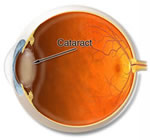| |
| |
|
Information
for Patients Undergoing Cataract Surgery
If you have been booked or contemplate being booked
for cataract surgery, please take note our current wait is approximately 1 year from the date of your consultation.
A cataract is an opacity or loss of clarity within the
lens substance of the eye. This is the focusing mechanism
of the eye.
|
 |
|
The
only method of improving vision if one has developed
cataracts is to perform a cataract extraction and replacement
of the lens within the eye with an implant. This surgery
is carried out at the Kamloops Surgical Centre and cannot
be done by means of laser. An ultrasound device, which
is a sophisticated instrument, is used. This device
shatters the lens substance leaving behind an empty
bag which will hold the new implant in place. This is
called phacoemulsifcation surgery.
Some of you may have heard that laser is performed to
clear cataracts and indeed, laser is used if this bag
which holds the lens in place later becomes cloudy.
|
|
Then
a short procedure can be performed to clear up this
membrane, however, the initial surgery is done by means
of a small incision into the eye and the ultrasound
device is then used to remove the cataract.
Recently a new type of folding intraocular lens or implant
has become available.This implant is folded outside
the eye to approximately half its diameter. It is squeezed
through an incision of approximately 3.0 mm. The implant
then unfolds inside the eye, and in this way we can
fit a 6 mm implant through a 3.0 mm incision. This allows
quicker wound healing and reduces the chances of complications.
The lens is now covered by BC Medical, but there is a measurement fee of $100 per eye. This
is payable before or on the day following the surgery
by either: Visa, Mastercard, American Express, Debit or personal cheques. We no longer accept cash. |
Surgical
complications are quite rare and include hemorrhage at
the time of surgery and technical problems encountered
during the surgery which may prevent me from putting an
implant adequately in place. Postoperatively, infection
is very rare at less than 1 in 1000 and retinal detachment
occurs at just less than 1%. For the most part however,
complications are quite rare and the vast majority of
patients are very happy with their surgery.
As with any surgical procedure however, untoward complications
not mentioned above can occur, but as mentioned, these
are quite rare. The surgery is carried out at the Kamloops Surgical Centre. You would be required to spend at least
a few hours there. The surgery which takes approximately
20 minutes is preceded by an injection of local anesthetic
around the eye which prevents eye movement and will prevent
you from feeling any discomfort during the surgery.
After the operation you will be expected to wait for approximately
one hour in the Outpatient Department after which you
can go home.
If you are from out-of-town you would be expected to stay
in a motel because I will have to see you the next day
in my office. This may be on a Saturday morning, but I
will see you. Arrangements for this appointment in my
office will be made immediately after the surgery. You
will be given an information brochure as to how to clean
the eye and what eye drops to use postoperatively.
The rehabilitation period varies, but usually vision has
improved by one week postoperatively and often vision
has improved even prior to this. You will be expected
to use drops in the eye for a period of two weeks. For
the first 1-3 days vision may be quite blurred and your
eye may feel scratchy and look red.
I will see you one day postoperatively and usually one
to two weeks later. Thereafter, you can follow-up with
your local Optometrist for a final pair of glasses between
two (for foldable lenses) and six weeks (for non-foldable
lenses) postoperatively depending on the size of incision.
The hope is to improve the power of the eye to reduce
the strength of your spectacles. Occasionally, you will
be able to dispense of your spectacles either for distance
or near, but invariably one would need spectacles either
for reading, for distance vision or for a combination
of both as the eye will lose it's ability to focus at
both distance and near.
If you have any further questions, do not hesitate to
contact me after you have read this pamphlet carefully.
Peter Hopp, MD |
| |
|
|
|
|
|
Interior Retina, Kamloops, B.C.,
Canada, Dr. Peter Hopp, argon laser treatments for diabetic retinopathy,
branch retinal vein occlusions, clinically significant macular edema,
central serous retinopathy, lattice degeneration, macular edema
and retinal tears, retinal detachments, vitreous hemorrhages, dropped
nucleuses, macular holes
|
laser treatment of the retina,
laser treatment for glaucoma, laser treatment for diabetic eye disease,
laser treatment for certain types of macular degeneration,surgery
for cataracts, retinal detachment, macular hole, epiretinal membrane,
diabetic retinal disease,vitreous hemorrhages, chalazion excision,
entropion, other miscellaneous retinal and vitreous disorders
|
Interior Retina, Kamloops, B.C.,
Canada, Dr. Peter Hopp, argon laser treatments for diabetic retinopathy,
branch retinal vein occlusions, clinically significant macular edema,
central serous retinopathy, lattice degeneration, macular edema
and retinal tears, retinal detachments, vitreous hemorrhages, dropped
nucleuses, macular holes
|
|
Interior Retina provides treatment
and management of glaucoma, iritis, scleritis, vein/artery occlusions,
diabetic eye diseases, corneal abrasions, double vision, floaters,
optic neuritis, uveitis and after-cataracts.
|
|
Multimedia Design Canada produces
complete digital design solutions with original logos, banners and
animations for print, internet or visual presentations.
|
|

